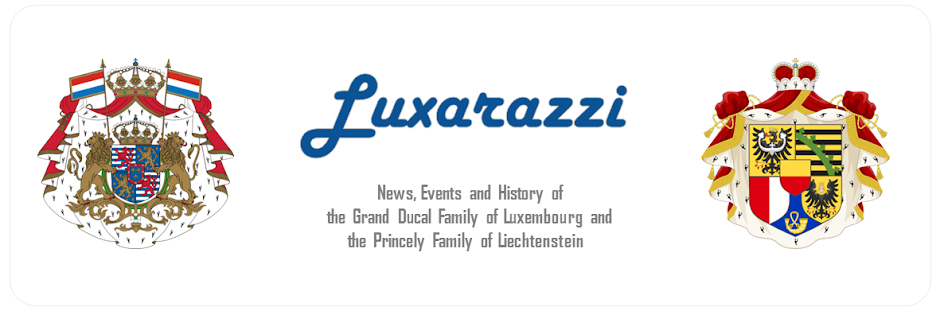Today in 1919 it was the wedding day of Grand Duchess Charlotte and her husband Prince Felix of Bourbon-Parma, one of the 24 children of the deposed Robert I, Duke of Parma. It had, however, been a bumpy road for the couple to get there and so we are going to have a look back.
Then Princess Charlotte and the captain of the Austrian army had gotten engaged sometime in 1918. To mark the occasion, the future Grand Duchess was given a sapphire and diamond ring. While I am not entirely sure whether the engagement happened before or after the end of the First World War, I can tell you that in December of that year Pope Benedict XV gave the necessary dispens needed due to their close relationship (their mothers were sisters).
The courtship between Princess Charlotte and Prince Felix had been known to the Luxembourgish public since at least 1915. Some say that it had started in 1913 around the time of the wedding of Prince Felix's sister Princess Zita to the future Emperor Karl I of Austria. Even though many considered it likely that Princess Charlotte would one day become the Grand Duchess of Luxembourg as her older sister Grand Duchess Marie-Adélaïde had indicated that she did not plan on getting married, nobody seriously expected it to happen only a few weeks after the couple's engagement was announced.
When Charlotte took the throne upon her sister's abdicaton on January 14, 1919 all wedding plans were put on hold and it was questioned whether the wedding would indeed take place as Prince Felix's time in the Austrian army raised suspicions within the country and he wasn't necessarily welcomed by everyone. In fact, the allies had even forbidden Prince Felix to go to Luxembourg for a few weeks after the end of the First World War due to his time in the Austrian army and his close relationship with the deposed Imperial Family. By the end of 1919 and after a referendum in favour of continuation of the monarchy under Grand Duchess Charlotte, the situation calmed down a little and the wedding went ahead as planned.
Like it seems to be a Luxembourgish tradition, there were a few many quarrels surrounding the question of Prince Felix becoming a Luxembourgish citizens and things turned quite ugly during the parliamentary debates. The law about his naturalisation was, however, passed on November 4 coming into effect a day later. Also on November 5, he was incorporated into the Luxembourgish nobility via arrêté grand-ducal as Prince Felix Marie Vincent de Bourbon de Parme and given the additional title of Prince of Luxembourg. Via a house decree, he was also made a Prince of Nassau though apparently the letter's patent was never issued.
The Grand Ducal Family and the cour had originally planned for the wedding to take place at Château de Berg as especially the marechal feared manifestations and rallies against the couple. Not only due to Prince Felix's background but also because of the referendum that took place only a few weeks earlier. It was the president of the Chamber of Deputies who convinced the couple to have their wedding in Luxembourg City and so they were married at the Cathédral Notre-Dame on November 6, 1919.
In the end, most of the concerns about possible protests turned out to be nothing more than fears as the great majority of the population cheered on the newly weds. In fact, Grand Duchess Charlotte and Prince Felix had to come out on the balcony of the palais grand-ducal numerous times during the course of the afternoon as more and more crowds of people gathered in front of the palace to see them.
Already in the evening of November 5, a ball had been held at the palais. On the next day at 10:30am, the couple was married civilly at the castle by mayor Housse. The civil wedding was a rather low-key affair only attended by immediate family members as well as the minister of state and the minister of justice.
The religious wedding, however, was an entirely different affair. While Prince Felix made his way down the aisle alongside his two brothers Prince Sixtus and Prince Xavier, who also acted as the two witnesses, Grand Duchess Charlotte was accompanied by her mother, Grand Duchess Maria-Ana, and her mother-in-law Duchess Maria Antonia of Parma.
The bride's gown was a creation by Parisian couturier Maison Beer and made out of heavy silk. Grand Duchess Charlotte chose to wear a medal commemorating her paternal grandparents' -- That's Grand Duke Adolph and Grand Duchess Adelheid-Marie in case you aren't good in Luxembourgish genealogy -- golden wedding anniversary alongside the Order of the Gold Lion of the House of Nassau. Wearing a tailcoat, Prince Felix sported the sash of the same Luxembourgish order as well as the stars of the Bourbon-Parmesan Constantinian Order of Saint George and the Royal Hungarian Order of Saint Stephen. Grand Duchess Charlotte anchored he lace veil with the Empire Tiara.
After the wedding at the cathedral, a reception took place at the the palais. As mentioned before, Grand Duchess Charlotte and Prince Felix had step out on the balcony to greet the cheering crowds a few times over the course of the day. But it wasn't just a day to celebrate the union of the newly weds but also a great day for Luxembourg in general as the British King George V had taken the wedding as an opportunity to send a congratulatory telegram in which he wished the couple all the best and also announced that his country would restore their diplomatic relations to Luxembourg.




No comments:
Post a Comment